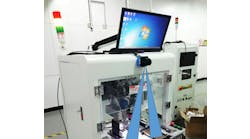“Honey, I’m home.” This was a normal thing to say in the 1950s and 1960s by Dad when he came home from work to let Mom and the family know that he had returned.
Today is different. My presence is known by simply approaching the house. My Ring camera goes off, my wife’s iPad tingles, and my phone lets Google Home know that I am on the premises—presence sensing at its best, and no words are even spoken.
Light curtains are used in robot cells to detect people who try and enter the cell at a time when they shouldn’t. I used light curtains to protect people who, for some strange reason, would traverse on a conveyor while a pallet wrapper was in operation, so that they didn’t get knocked out by the whirling arm.
We use various devices to sense things. People, product, air quality and pollutants, static location and movement are some of the myriad things that may need to be sensed. The reasons that they would need to be sensed are wide and deep.
Parts in place—photocell, proximity switch, limit switch—has been implemented for many years in the land of automation. With the advent of programmable logic controllers (PLCs) and programmable automation controllers (PACs) and control software, wiring in sensing hardware and using that information for control, feedback, alarming and trending has become commonplace.
Analog sensing is also employed, as 4-20 mA signals for level, speed and the like are used in everyday solutions for automated processes and machines.
Modern sensors have built-in networking capability to allow for the use of these devices anywhere on the machine and/or process.
Radio-frequency identification (RFID) technology is being implemented in the field. Imagine if your phone could connect you to a machine-control system simply by being in its presence. Well, if the machine can support Bluetooth, and the mobile app on your phone can talk to that machine, then it can.
Your presence can be determined by your proximity to the machine. I have a new car whose key fob allows me to actually enter the car without unlocking it with the fob. It senses my proximity and marries my fob to the car so when I touch the door handle the doors unlock. My foot can open the back hatch, so it knows that it is me and senses my foot to open the hatch.
The opposite is also true. If someone does not have my fob and tries to open the hatch, they will not be successful.
So, sensing has two sides—there and not there; presence and absence.
It is important in a control narrative to determine which one needs to be sensed for the action at hand. Sometimes, it is both.
In a previous project back in the 1980s I was using a proximity switch to gauge conveyor speed by counting teeth on the flywheel of the chain-driven system. I looked at the end of the tooth and then at the absence of the tooth. Knowing the distance of the tooth not being there and the time between the teeth being sensed, I determined the speed in lugs/min, which the customer needed for acceptance testing.
Now, I would use a resolver or encoder, giving me the speed, which could be converted. A variable-frequency drive (VFD) would be employed instead of the hydraulic drive that was being used.
Sensing comes in many different packages with various connectivity options, such as Bluetooth, Wi-Fi, Ethernet and, of course, ac/dc direct connectivity.
The real question is why. Why do we need to sense anything? Safety comes to mind, as well as the process. When we implemented the light curtain for the wrapper it was for people and the machine. The wrapper might be damaged by having the arm hit by anything, and, if it were a person, well, that just can’t happen.
Sensing is an integral part of any control narrative from a process and discrete point of view. Water treatment systems, making beer, a favorite of mine, an x-y machining table and drill platform all are different in function but similar in that they all need sensing of product, location and action, such as that valve needs to be closed.
The cost of adding a sensor can be very insignificant to the cost of the machine and/or process. The cost of fixing a busted system because you failed to sense that all stations are home on a dial-table application could be expensive.
But we wouldn’t do that, would we? Using our common sense will win the day.





